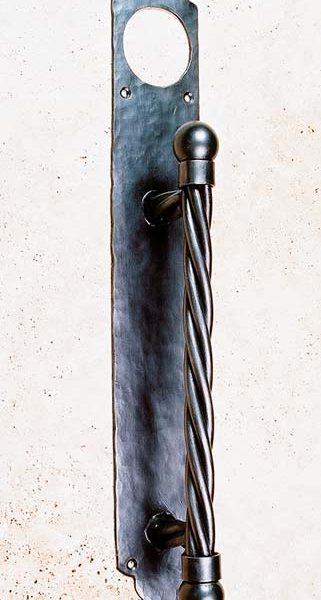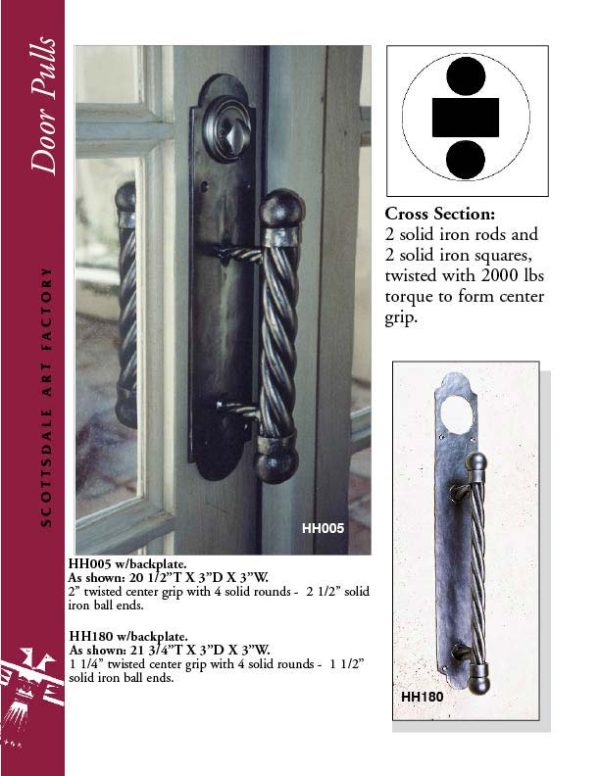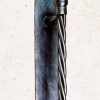Description
Door Handle – Chateau de Chevreaux Style 15th Cen.
Ball and Twist With Backplate - Hand Forged By Our Master Blacksmiths - H J Nick Certified Originals Are Heavy Detailed To World Fine Art Standards - Solid Hand Forged Wrought Iron - (No casted copies or hollow metals) - 5 Process Heat Patina Finished To World Class Antique Collectors Standards - ( No Spray On Faux Paint Jobs) - Guaranteed Forever - Order Any Size Or Style - Virtually Maintenance Free - Guaranteed Forever - Backed By Our Over Nine Decades Of Fine Craftsmanship Since 1913.
Historical Origin And Design Inspiration
A blacksmith is a person who creates objects from iron or steel by forging the metal; i.e., by using tools to hammer, bend, cut, and otherwise shape it in its non-liquid form. Usually the metal is heated until it glows red or orange as part of the forging process. Blacksmiths produce things like wrought iron gates, grills, railings, light fixtures, furniture, sculpture, tools, agricultural implements, decorative and religious items, cooking utensils, horse shoes and weapons.
A blacksmith's striker is an assistant (frequently an apprentice), whose job it is to swing a large sledge hammer in heavy forging operations, as directed by the blacksmith. In practice, the blacksmith will hold the hot iron at the anvil (with tongs) in one hand, and indicate where the iron is to be struck by tapping it with a small hammer held in the other hand: the striker then delivers a heavy blow with the sledge hammer where indicated.
When iron ore is smelted into usable metal, a certain amount of carbon is usually alloyed with the iron, (charcoal is almost pure carbon). The amount of carbon has extreme effects on the properties of the metal. If the carbon content is over 2%, the metal is called cast iron. Cast iron is so called because it has a relatively low melting point and is easily cast. It is quite brittle however, and therefore not used for blacksmithing. If the carbon content is between 0.25% and 2%, the resulting metal is tool steel, which can be heat treated as discussed above. When the carbon content is below 0.25%, the metal is either "wrought iron" or "mild steel." The terms are never interchangeable. In pre-industrial times, the material of choice for blacksmiths was wrought iron. This iron had a very low carbon content, and also included up to 5% of glassy slag. This slag content made the iron very tough, gave it considerable resistance to rusting, and allowed it to be more easily "forge welded," a process in which the blacksmith permanently joins two pieces of iron, or a piece of iron and a piece of steel, by heating them nearly to a white heat and hammering them together.
Hephaestus (Latin: Vulcan) was the blacksmith of the gods in Greek and Roman mythology. A supremely skilled artisan whose forge was a volcano, he constructed most of the weapons of the gods, and was himself the god of fire and metalworking.
Most Designs Used Today Were Conceived Hundreds Of Years Ago By Some Of The Worlds Most Famous Architects And Designers Working For The Aristocracies And The Well To Do Of Their Period. Many of these architects and designers are as well known as Leonardo da Vinci (renaissance architecture) or Michelangelo,s (baroque architecture) as well as more recently William Morris, John Ruskin (founders of the Arts and Crafts furniture movement in circa 1800 England) Gustave Stickley (founder of the American Arts and Crafts movement in America circa 1900.) Frank Loyd Wright, Charles and Henry Greene to name a few.










Reviews
There are no reviews yet.